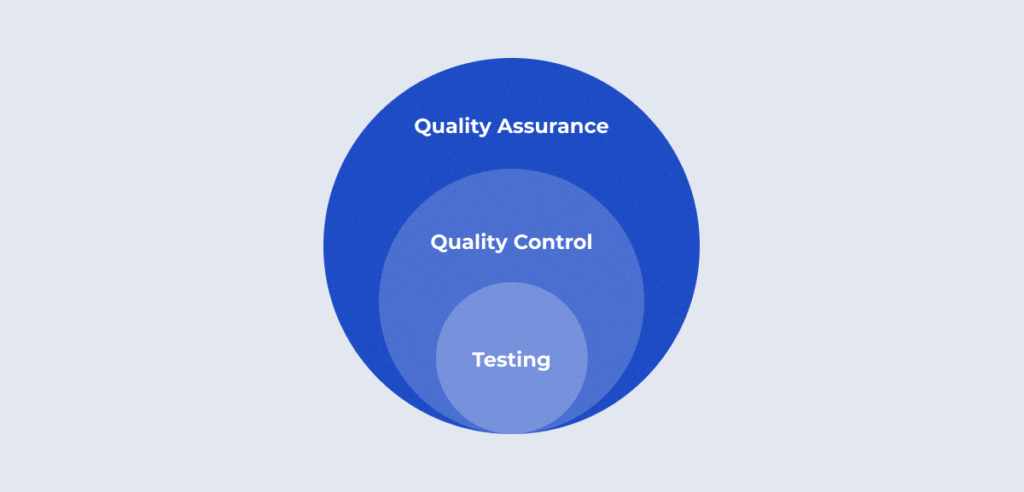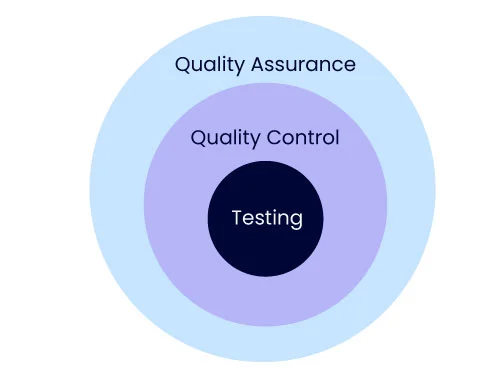Introduction
Difference Between QA, QC, and Testing Sometimes, the terms used interchangeably can be misleading. So, what is common in QA, QC, and testing that the general public often misuses these terms? Let’s understand these concepts from an IT perspective. First off, it’s important to note that they are distinct because they serve different purposes in the software development process. While they are related to ensuring quality, each one focuses on a unique aspect.
In this blog, we will explore the about QA, QC, and testing and help you understand how they are apart from each other.That said, at H2K Infosys, we offer Quality assurance training and placement service for candidates with IT/non-IT background and beginners.
QA, QC, and Testing – The Difference
What is QA?
Quality Assurance (QA) is a proactive process. It is all about process improvement and preventing incumbent defects. The ultimate job of the QA is to perform the root cause analysis to seal off the errors once and for all. In a usual practice when the errors crop up, the quick fixes during unit testing hide them temporarily. However, they recur with a slight change in the testing environment. Apart from fixing such errors, the QA also ensures that the end-product does meet customer expectations.
Although QA is a proactive process and might seem to be unnecessary from an outsider perspective, it is one of the best investments businesses make. Why? Because, by the time the Quality Control comes into the picture, it is too late by then. This comes at a later stage in the Software Development Life Cycle (SDLC) and fixing bugs at that point can prove to be a very expensive exercise for the companies. The QA process essentially saves time, money and effort.
What is QC?
QC, or Quality Control, is a crucial process in software development, focusing primarily on ensuring the final product meets the required standards and specifications. Unlike Quality Assurance (QA), which is a proactive process aimed at preventing defects, It is reactive, identifying and fixing issues that surface during or after the software development process.
QC: Reactive but Crucial
While it’s often considered less proactive than QA, QC plays a critical role in the overall quality of the product. It focuses on identifying defects, inconsistencies, and any deviations from the desired specifications. Without QC, even the most well-planned and well-executed software development process can fail to deliver a reliable product.
Why QC is So Essential
Despite being reactive, QC ensures that the software is free from bugs and defects before it reaches the end user. This process not only improves the overall quality of the product but also helps minimize the risk of customer dissatisfaction. By identifying flaws early, It helps prevent costly rework and ensures that the product meets industry standards.
The Relationship Between QA and QC
Though distinct, QA and QC are complementary processes. QA aims to prevent issues by refining processes and standards, while QC acts as the final checkpoint, verifying that the product meets the necessary criteria. Together, they ensure that the product is both high-quality and functional, fulfilling user expectations.
While QC is reactive in nature, its role is indispensable in delivering a product free of defects. By catching issues at the end of the development cycle, QC ensures that the software meets both functional and non-functional requirements, contributing to the success of the product and the satisfaction of the end-users.
End of the day it is the product that matters to the customer.
Having said that, the job of a Quality Control mainly include constant reviewing of the product at every phase of the process, software testing, and code inspections.
What is Testing?
In the context of software development, testing is the process of evaluating a software application or system to ensure that it functions correctly and meets the specified requirements. Testing helps identify bugs, defects, or any discrepancies in the software, ensuring that the product is of high quality before it reaches the customer. It is the final stage in the quality control (QC) process, where the product is tested against predefined criteria to verify its performance, functionality, and reliability.
Testing: The Final Checkpoint
Testing is often considered the final checkpoint in the software development lifecycle (SDLC). Once the software has passed through various stages, including design and development, testing is the process that verifies its readiness for release. It checks if the product works as expected, meets user requirements, and aligns with the customer’s expectations. Without proper testing, there is always a risk that critical flaws might be overlooked, which could lead to costly failures after deployment.
Why Testing is Crucial for Product Delivery
Testing is crucial because it ensures that the software meets both functional and non-functional requirements. This includes verifying that the application performs its intended functions correctly, has good user experience (UX), and operates under expected conditions. It also ensures that the software is secure, scalable, and compatible with different environments, devices, or operating systems. By thoroughly testing the software, teams can mitigate the risk of releasing a product that could cause customer dissatisfaction, security issues, or performance problems.
Types of Testing
There are various types of software testing, each serving a different purpose. Some common types include:
- Unit Testing: Focuses on individual components or units of code to ensure they work as intended.
- Integration Testing: Ensures that different modules or systems within the software work together smoothly.
- Functional Testing: Verifies that the software’s features and functions work according to the requirements.
- Performance Testing: Assesses how well the software performs under different loads, ensuring it can handle peak usage.
- User Acceptance Testing (UAT): Conducted by end-users to ensure the software meets their needs and expectations.
Testing Methods: Manual vs. Automated
Testing can be conducted manually or through automated testing tools.
- Manual Testing: Involves human testers who manually execute test cases and report issues based on their observations. It is typically used for exploratory, usability, and ad-hoc testing.
- Automated Testing: Involves using tools to run tests automatically, which can be particularly useful for repetitive tasks, regression testing, and performance testing. Automated testing helps save time and increases the accuracy and efficiency of the testing process.
The Role of Testing in Quality Assurance
While testing is a part of the broader Quality Control (QC) process, it plays a critical role in Quality Assurance (QA). QA focuses on preventing defects throughout the software development lifecycle, whereas testing focuses on detecting defects before the software is released. By incorporating both QA and testing practices, teams can ensure that the product is of high quality, functions as expected, and is free from defects that could affect user satisfaction.
What is common in all three processes?
Now that we have understood the difference between the three, what do they have in common? Net-net, all three processes work together towards a common goal, which is delivering the ultimate product that meets the customer expectations by all means.
Hope that clears the ambiguity in using all three terms interchangeably.
Key Differences Between QA, QC, and Testing
In software development, Quality Assurance (QA), Quality Control (QC), and Testing are essential components that ensure the product meets the required quality standards. Although these terms are often used interchangeably, each has a unique focus and objective in the software development lifecycle (SDLC). Let’s explore the key differences between these three concepts in more detail.
Focus
- QA (Quality Assurance): QA is process-oriented and focuses on prevention. The primary goal of QA is to design and implement processes, methodologies, and standards that reduce the likelihood of defects. QA focuses on ensuring that the development team follows best practices and effective processes to prevent errors from occurring.
- QC (Quality Control): QC is product-oriented, meaning it focuses on detection. The goal of QC is to identify defects in the product after development has been completed. It involves activities such as inspecting and reviewing the software product to ensure that it meets predefined standards and specifications.
- Testing: Testing is primarily concerned with the execution of tests to find defects in the software. This is done by verifying that the software works as expected in terms of functionality, performance, and user requirements. It includes various types of tests such as functional testing, unit testing, and acceptance testing.
Objective
- QA (Quality Assurance): The objective of QA is to improve processes, reduce risks, and prevent defects before they occur. It works to ensure that development processes are efficient, and that quality standards are being met throughout the lifecycle of the project.
- QC (Quality Control): QC’s objective is to detect defects in the product after it has been developed. QC ensures that the software meets the specifications and functions correctly by identifying issues through testing and inspections.
- Testing: The objective of testing is to validate if the software meets requirements. This is done by checking if the software behaves as expected in different conditions, under various environments, and according to the user’s needs.
Conclusion
In conclusion, Quality Assurance (QA), Quality Control (QC), and Testing are three essential components in the software development process, each with distinct roles but all aimed at ensuring the software meets the required quality standards. QA is process-driven, focusing on preventing defects from the start, while QC focuses on detecting and fixing defects in the product.
Testing, as a subset of QC, ensures that the software works as expected and meets user requirements. Understanding the difference between these terms and their respective roles is vital for any organization aiming to improve its software development process and deliver high-quality products.

































